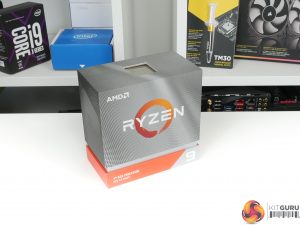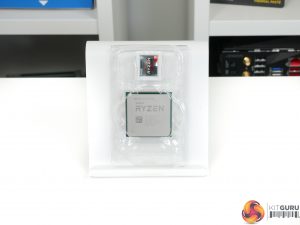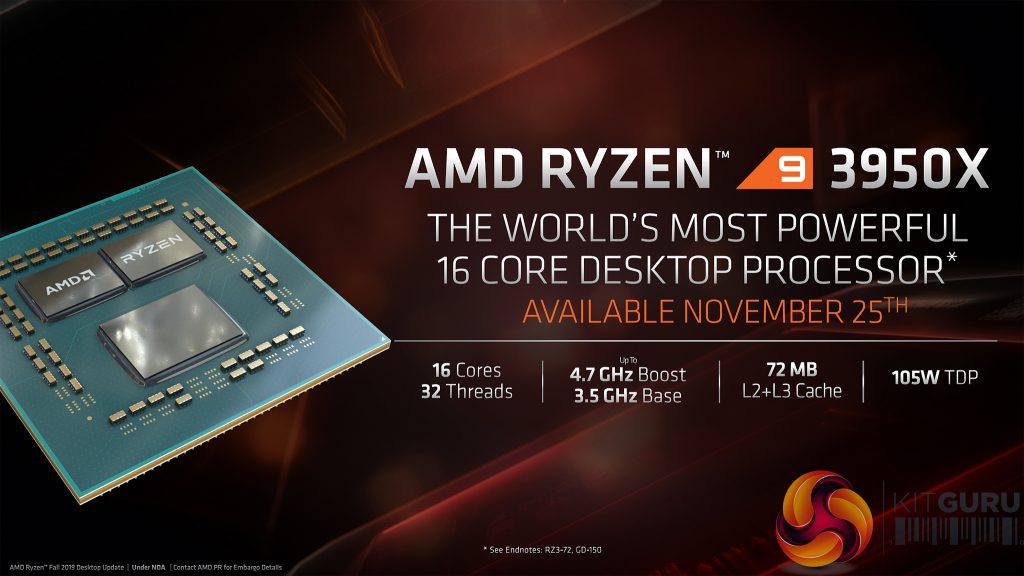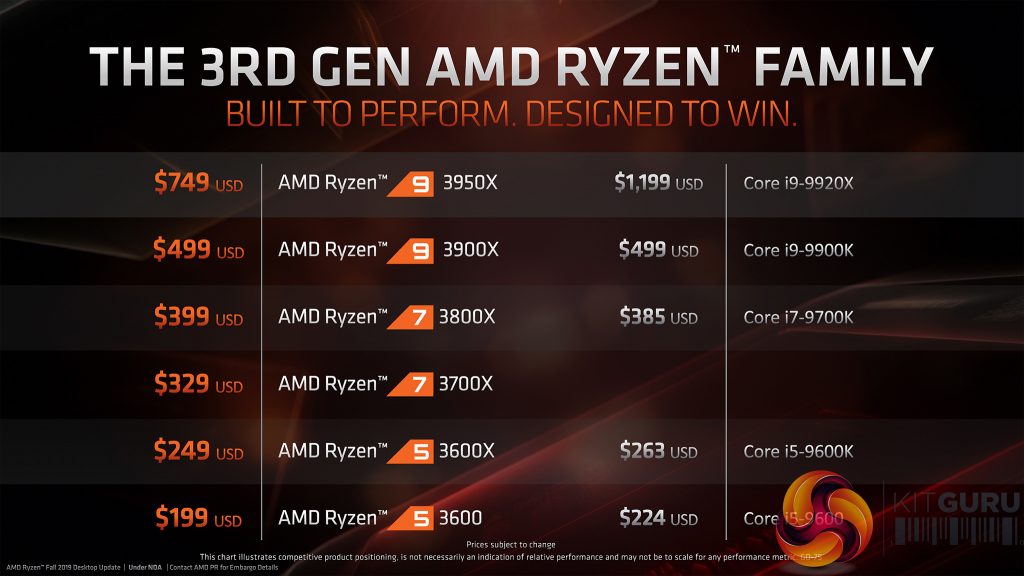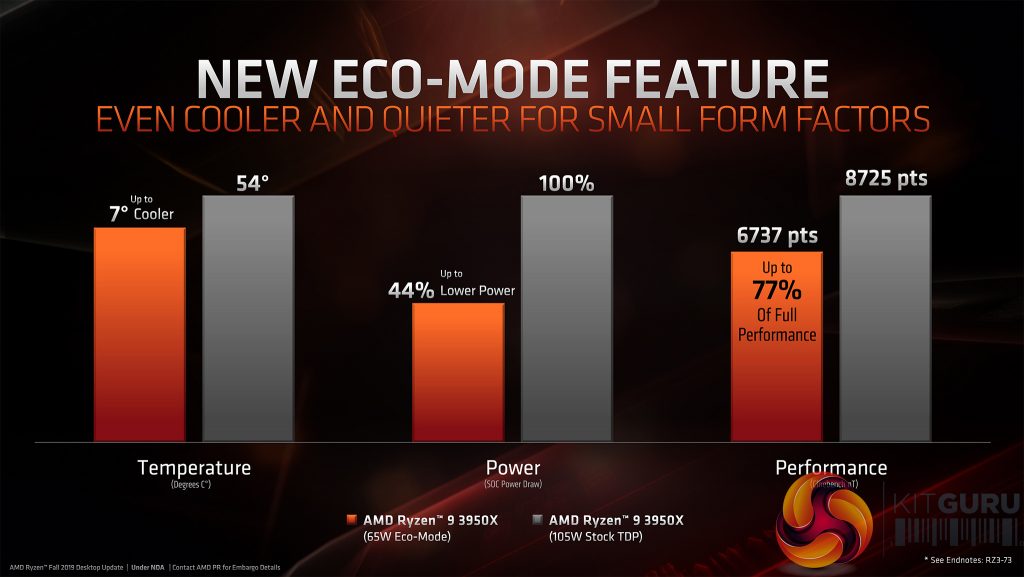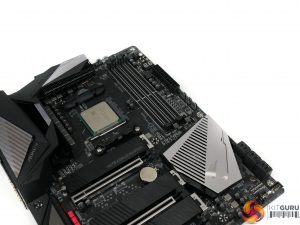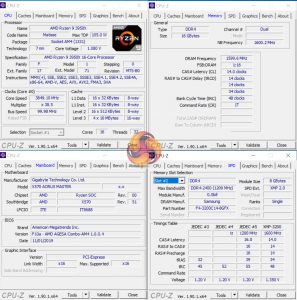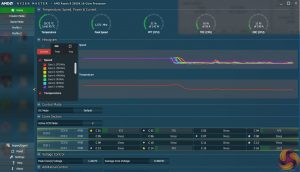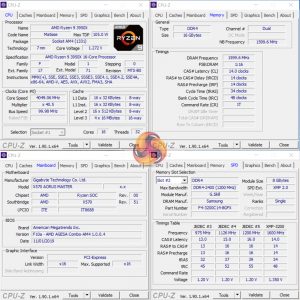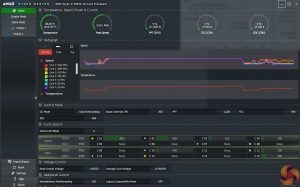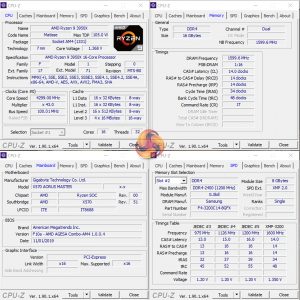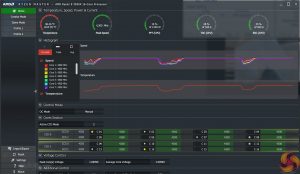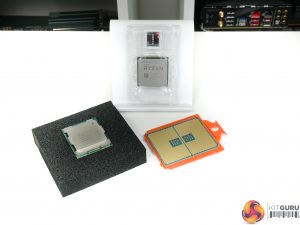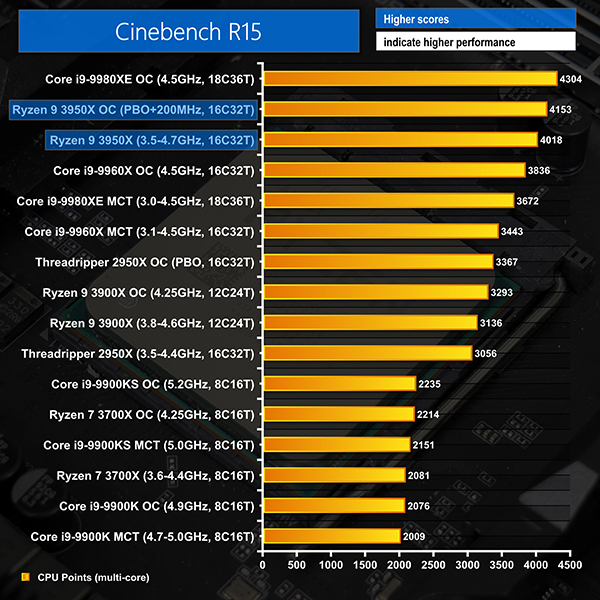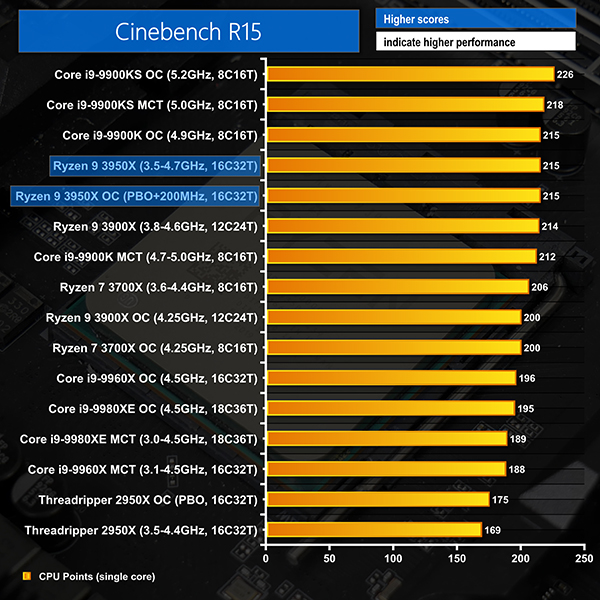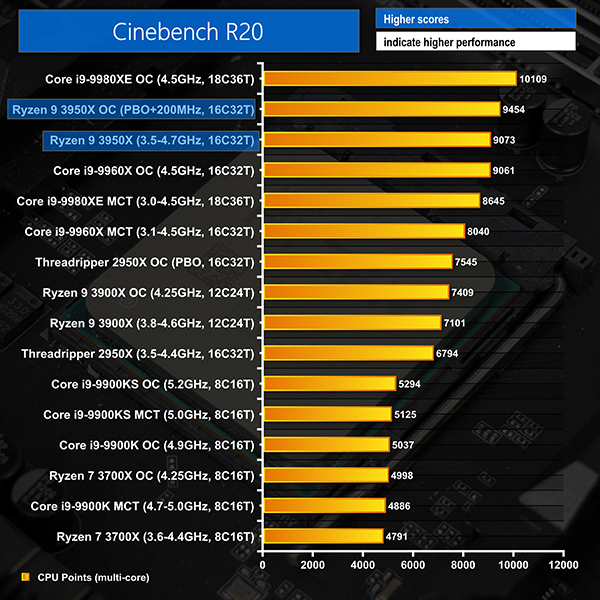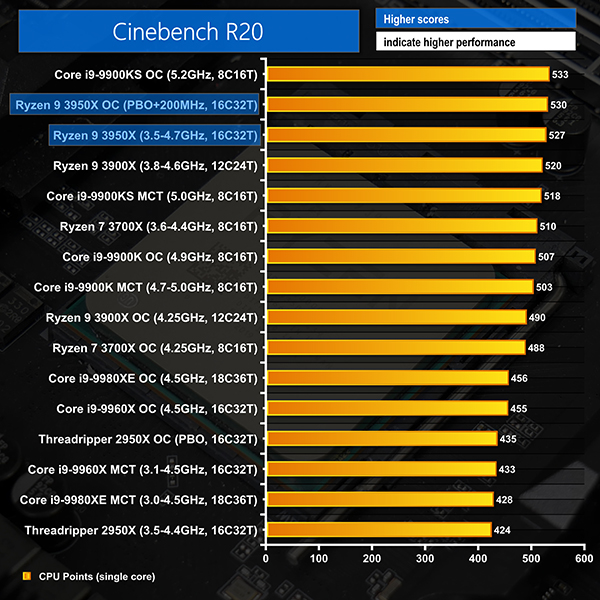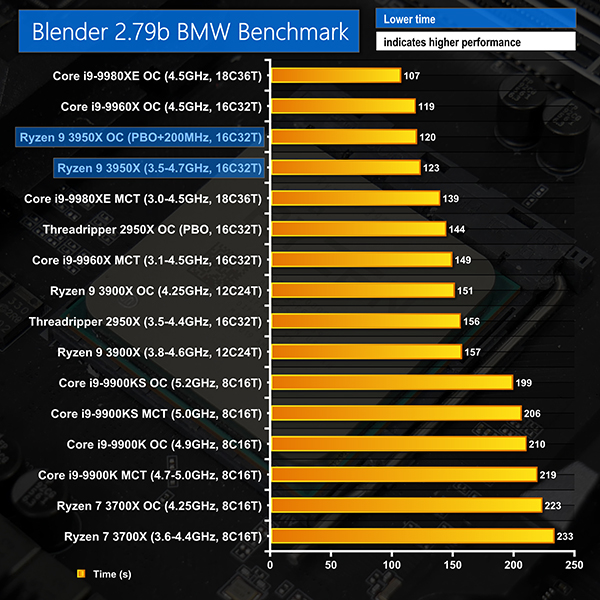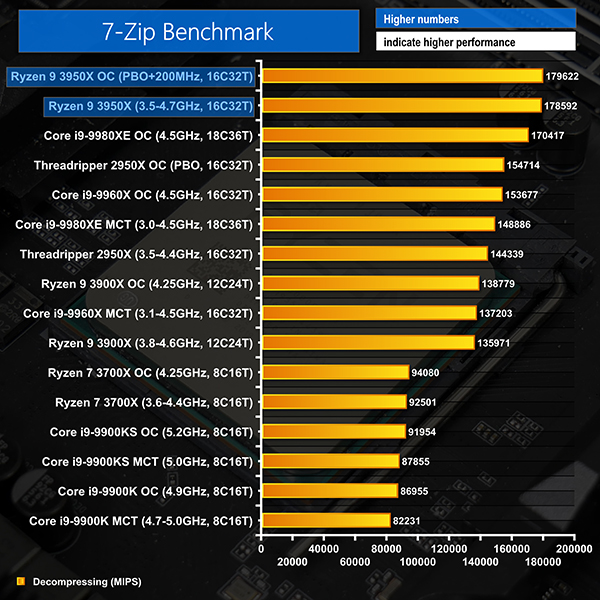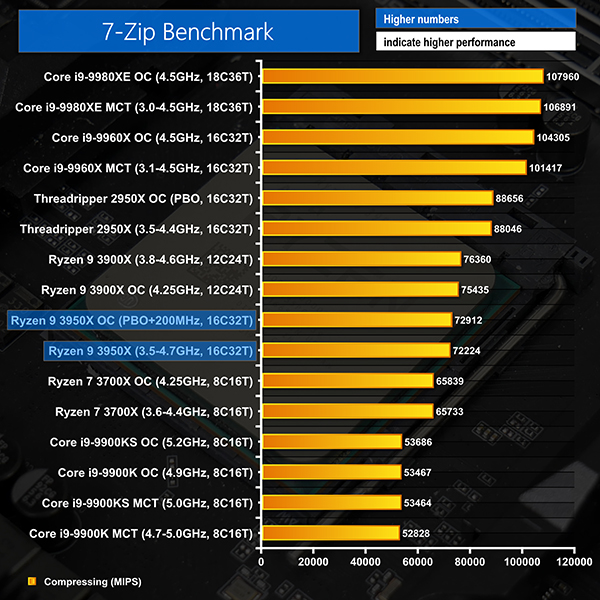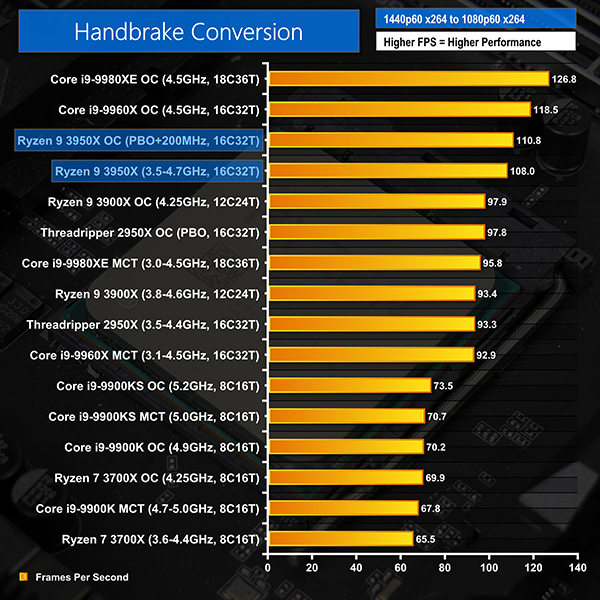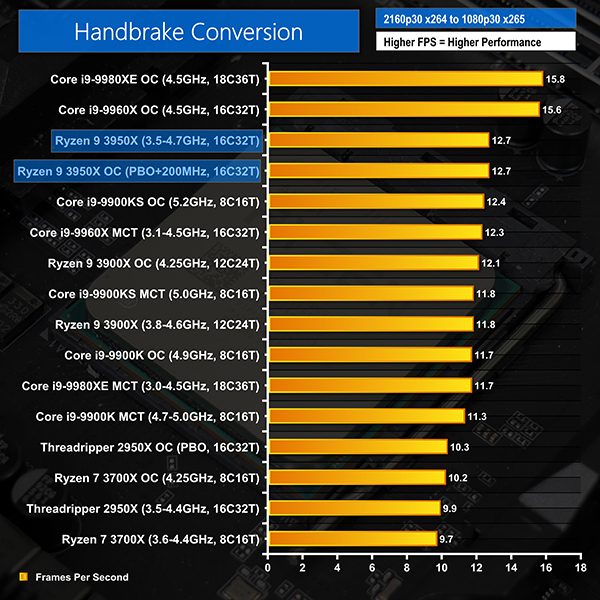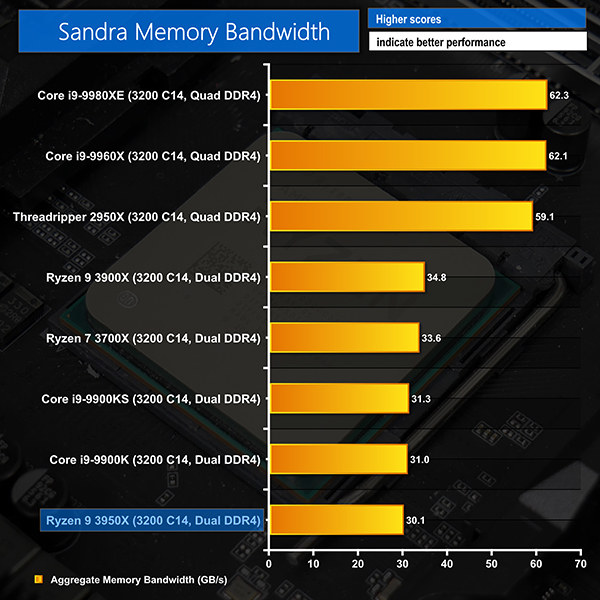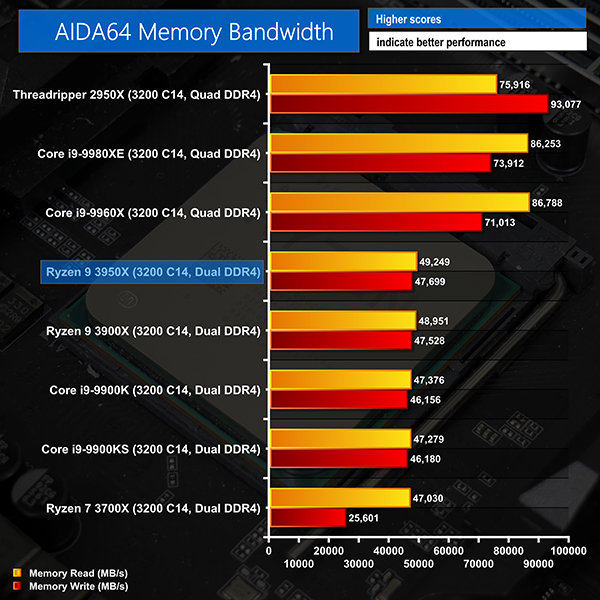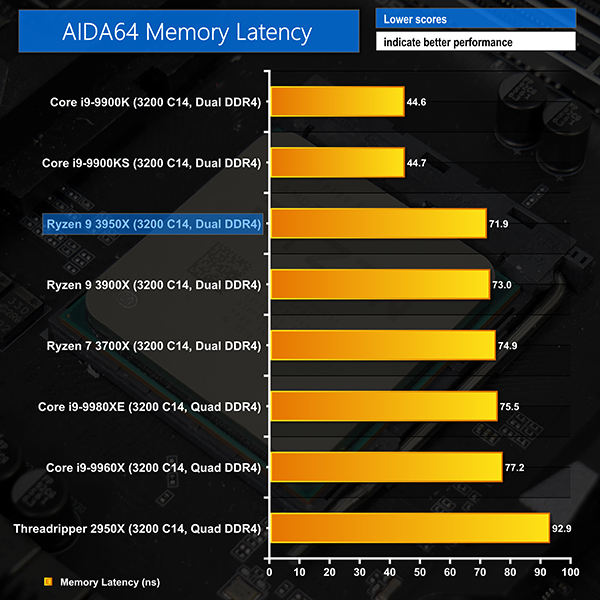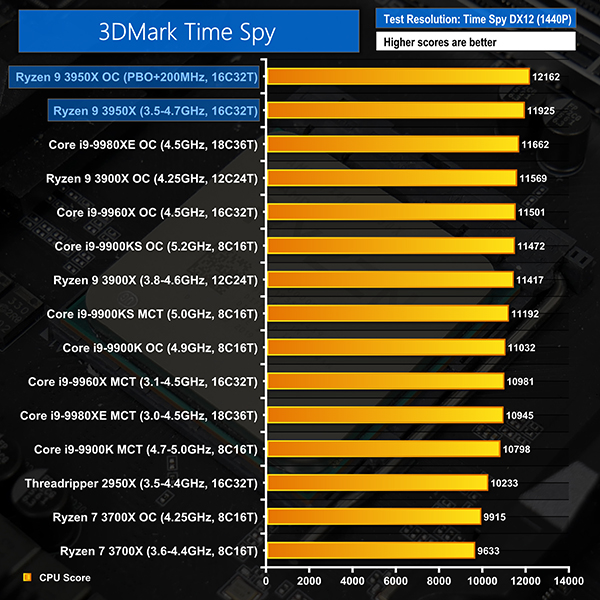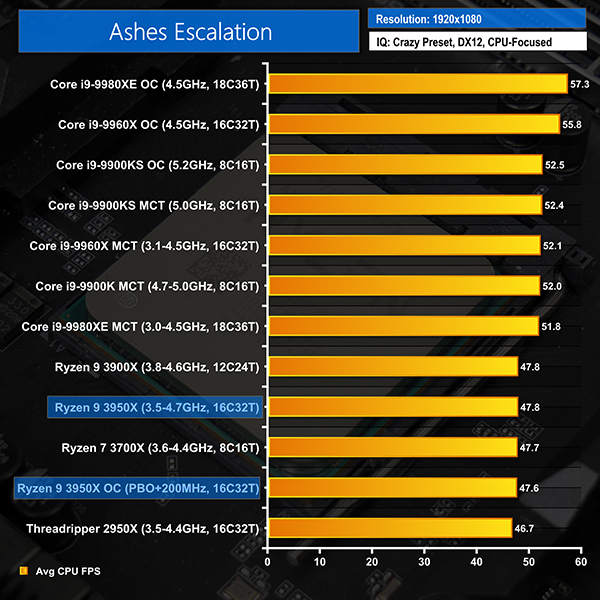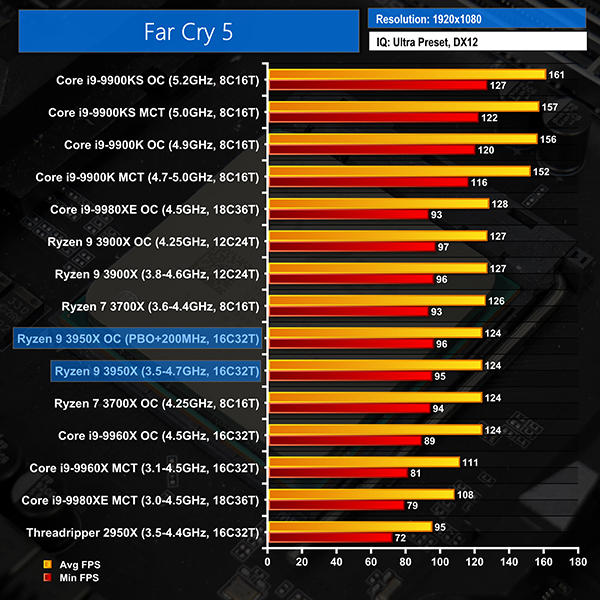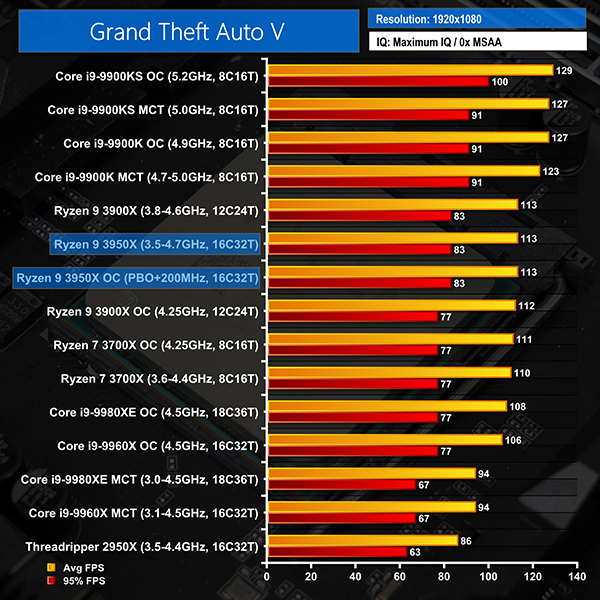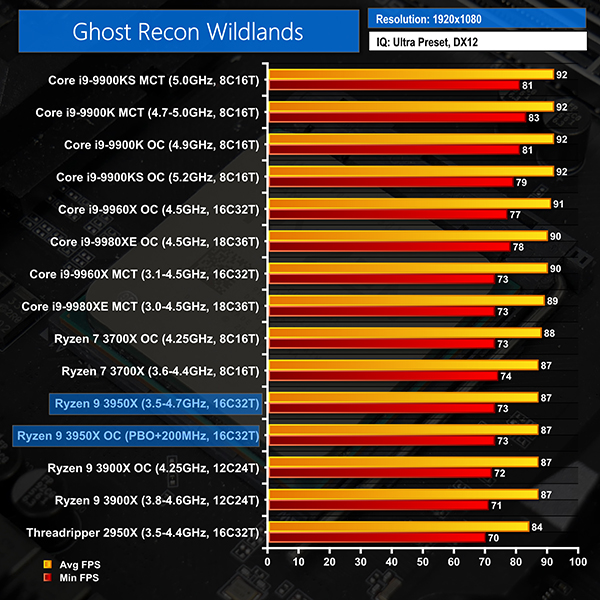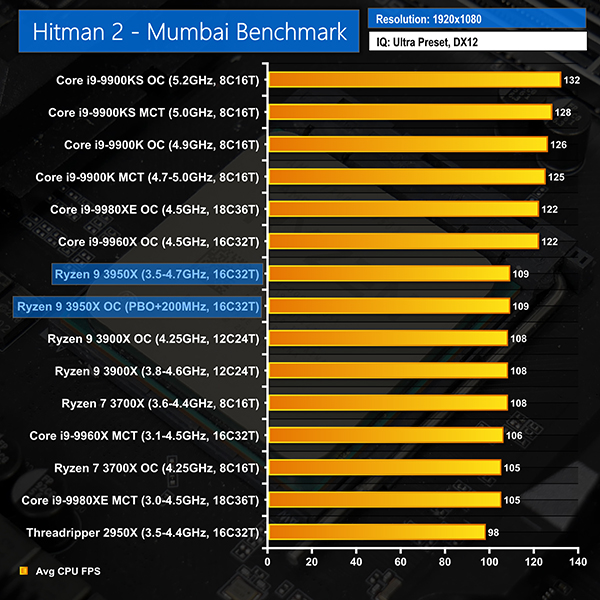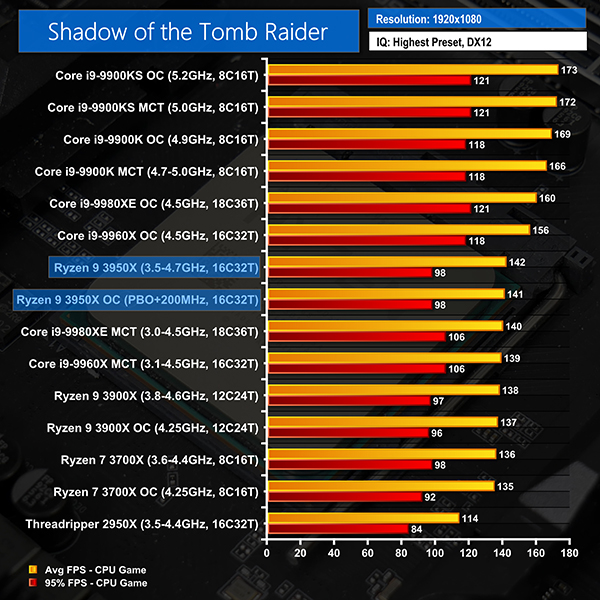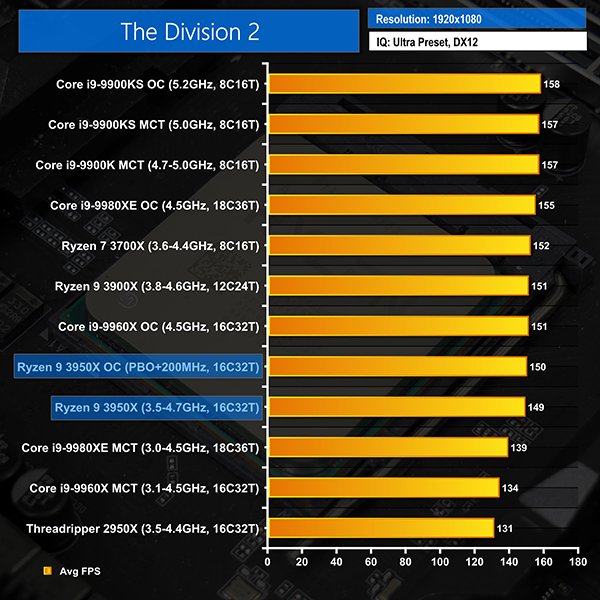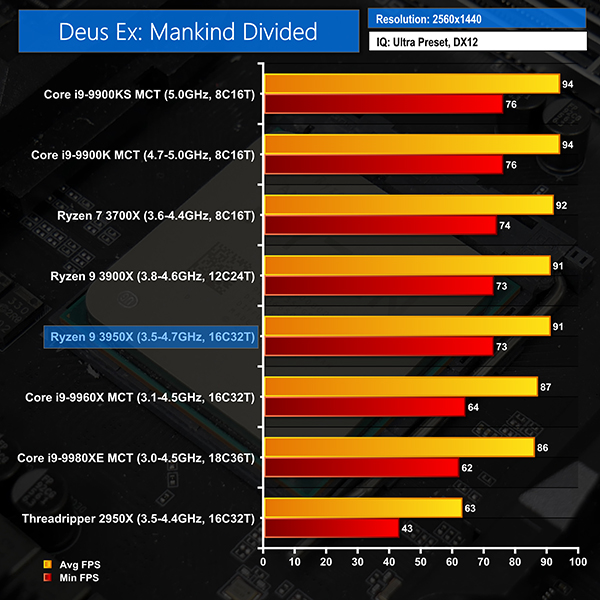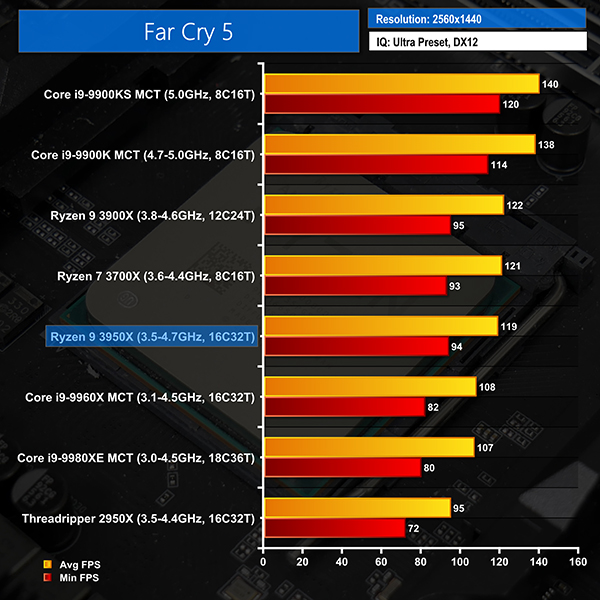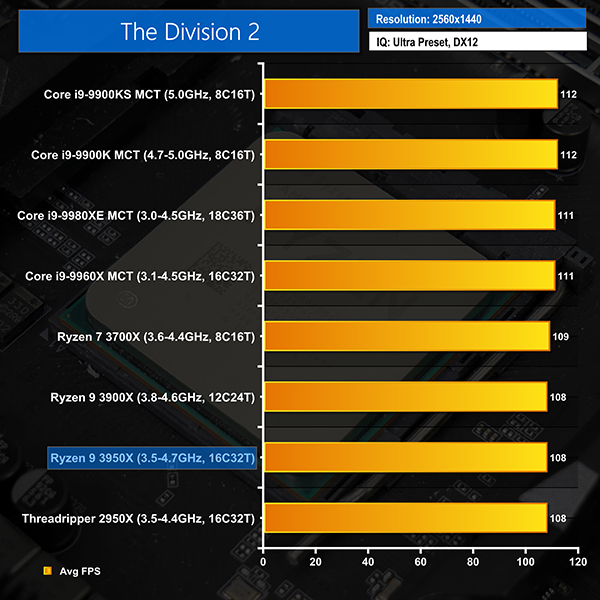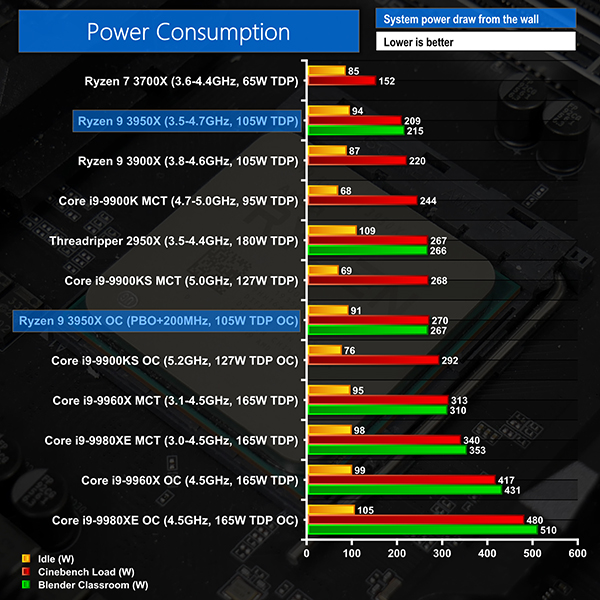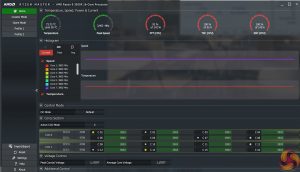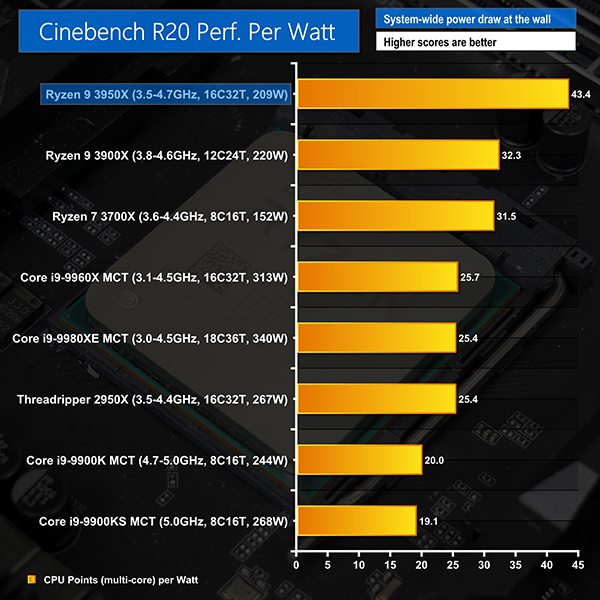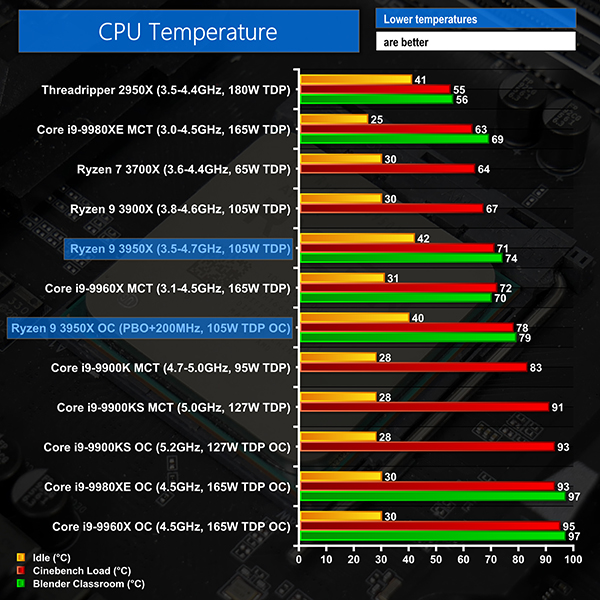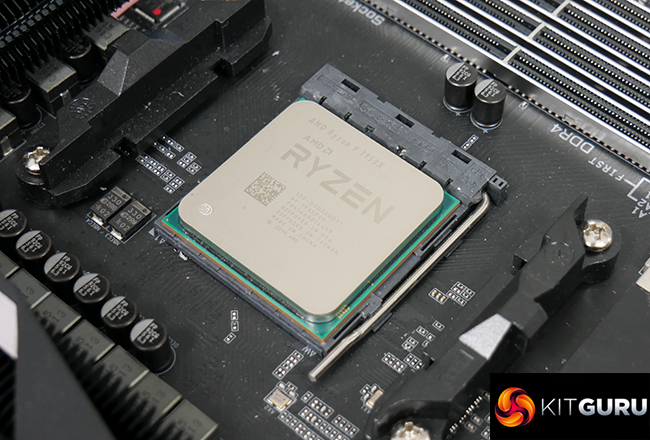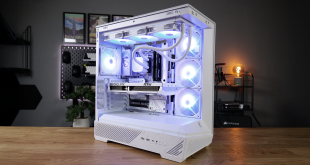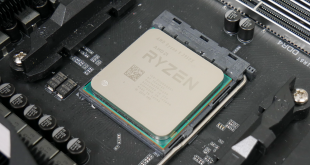
The wait is over for AMD's eagerly anticipated 16-core Ryzen 9 3950X processor. Slotting into the AM4 socket, the Ryzen 9 3950X represents a change in the level of performance now available to users on a mainstream platform.
Just a few short months ago, core counts and performance promises of this magnitude would have necessitated AMD's or Intel's High-End Desktop (HEDT) platforms. Roll the clock forward to today, and that is no longer the case.
Other than the additional cores, adjusted boost clocks, and different cache values, the new AM4 flagship Ryzen 9 3950X is all but identical to its 12-core 3900X sibling. That's no surprise, really, as similarity between parts is one of the principles for AMD's Zen 2 strategy.
Just so it's crystal clear, the Ryzen 9 3950X is a 16-core AM4 processor that is built around the Zen 2 architecture and TSMC's 7nm process technology. Made up of three chiplets – two core dies and one IO die – the Ryzen 9 3950X is basically a 3900X with all four of its CCXs fully populated.
Interestingly, AMD maintains the TDP at 105W to ensure compatibility with AM4 motherboards specced for 95W/105W processors. The trade-off for the somewhat constrictive TDP is a 3.5GHz base clock which represents a 300MHz reduction compared to the 3900X. On the higher core count chip, however, maximum boost frequency is increased to 4.7GHz – up from the 12-core's 4.6GHz. Of course, all of the usual caveats regarding the boost frequency workings for AMD's Precision Boost 2 algorithm (and processor marketing team) apply.
Priced at $749, the 3950X is a 50% price premium over the Ryzen 9 3900X for 33% more cores. Clearly, AMD understands that the Ryzen 9 3950X gives them a position of unique strength in the market and the processor is priced accordingly. Costs aside, we must cross our fingers that availability with this chip is less of an issue than what we have seen for other Ryzen 3000 parts – most notably the Ryzen 9 3900X. The official retailer ‘on-shelf' date is 25th November.
AMD does not include a CPU cooler with the new flagship. I have no complaints regarding that decision – anybody buying a $749 high-performance processor should also be more than willing to research and purchase an appropriate cooler. AMD recommends a 280mm (or larger) AIO, though there's no reason why high-end 240mm AIOs or beastly air coolers such as the Noctua NH-D15 won't work smoothly. After all, AMD's smart Precision Boost 2 algorithm factors in temperatures and dynamically adjusts the relevant settings if the heat is starting to look a little high.
One nifty feature that is launching in close proximity to the Ryzen 9 3950X is AMD's new Eco Mode. This software-based feature allows users to crank their Ryzen 3000 CPU down by one TDP bin. So, 95/105W TDP parts will drop to 65W TDP and adjust their operating characteristics accordingly. That could be ideal for Plex server enthusiasts, tinkerers who want 24/7 virtual machines running, or even system builders struggling to cool sixteen cores in a mini-ITX form factor.
Anyway, enough of the details that most of us probably already knew. Let's jump into the testing.
Our objective with CPU overclocking is to hit frequencies that we think will be achievable for daily use by the platform’s buyers. As such, we test with sensible cooling hardware in the 240mm Corsair H100X with two 2435 RPM SP120L fans. We also aim to use sensible voltages that lead to manageable thermal results.
Stability is confirmed by running multiple Cinebench tests, Handbrake video conversion, and extended Blender rendering runs. We do not use Prime95 as we have found it to be overly demanding as a stress test application with the more recent AVX-capable versions.
The partnering hardware of choice is the Gigabyte X570 Aorus Master motherboard, 16GB of 3200MHz CL14 DDR4, and a Seasonic Prime 1000W Titanium PSU.
AMD Ryzen 9 3950X Stock Frequencies:
We observed boost clocks pushing up against the 4700MHz quoted figure in Cinebench R20 single-threaded testing. Additionally, HWMonitor and HWINFO reported maximum core clocks as 4700MHz following our batch of gaming tests (we actually saw some readings of 4725 and 4750MHz). These were single-core boost clocks for the preferential core on our sample, which happened to be Core 0.
Stock all-core frequencies in Cinebench R20 were generally around 3900MHz. Blender tended to be a little higher at 3950MHz. We saw certain tests where the all-core boost clocks would drop below 3.9GHz, but staying above 3.8GHz was generally a safe bet.
AMD Ryzen 9 3950X Precision Boost Overdrive + 200MHz Auto OC Frequencies:
Using PBO plus the 200MHz Auto OC, all-core loaded boost clocks jumped to around 4050-4100MHz. Single-core maximum boost clocks didn’t really change, as expected, with peaks of around 4675MHz regularly observed on Core 0.
AMD Ryzen 9 3950X Manual Overclocking Frequencies:
We were able to hit a quick-and-dirty 4.3GHz when manually tuning with 1.35V and Turbo LLC in our Gigabyte motherboard's UEFI. This proved stable for a few runs of Cinebench R20 but temperatures were clearly too high to run for any extended period of time.
If you want to overclock manually with a static all-core value, make sure your cooling hardware is up to scratch. Otherwise, PBO is a smart option thanks to its ability to keep the potential boost capability.
We will be outlining the AMD Ryzen 9 3950X CPU's performance while using Gigabyte X570 Aorus Master motherboard. A 16GB (2x8GB) kit of 3200MHz CL14 DDR4 memory serves our test system.
Today's comparison processors come in the form of:
- Coffee Lake Core i7-9700K (8C8T), Core i9-9900K (8C16T), and Core i9-9900KS (8C16T).
- Skylake-X Core i9-9960X (16C32T) and Core i9-9980XE (18C36T).
- Matisse ‘Zen 2' Ryzen 9 3900X (12C24T) and Ryzen 7 3700X (8C16T).
- Zen+ Ryzen Threadripper 2950X (16C32T).
Each processor is tested at its default out-of-the-box settings. We also include reasonable overclocking performance data where relevant. For the Intel CPUs, forced turbo is enabled by default when XMP is enabled and, in most scenarios, cannot be disabled. As such, we test using the forced turbo frequencies with the Intel processors. All-core load frequencies for the tested chips are as follows:
- Core i9-9900KS = 5.0GHz.
- Core i9-9900K = 4.7GHz.
- Core i9-9980XE = 3.8GHz (without AVX2/AVX-512 reductions).
- Core i9-9960X = 4.0GHz (without AVX2/AVX-512 reductions).
- Ryzen Threadripper 2950X = Around 3550-3600MHz.
- Ryzen 9 3900X = Around 4050MHz (F7b BIOS, AGESA 1.0.0.3ABBA).
- Ryzen 7 3700X = Around 4050MHz (F7b BIOS, AGESA 1.0.0.3ABBA).
- Ryzen 9 3950X = Around 3800-3950MHz (F10a BIOS, AGESA 1.0.0.4).
CPU Test System Common Components:
- Graphics Card: Gigabyte Aorus RTX 2080 Ti XTREME (custom fan curve to minimise thermal throttling).
- Memory: 16GB (2x8GB) G.Skill 3200MHz 14-14-14-34 DDR4 @ 1.35V (4x8GB for quad-channel systems).
- CPU Cooler: Corsair H100X with 2435 RPM SP120L fans.
- Games SSD: Aorus 2TB PCIe Gen 4 M.2 SSD & Crucial MX300 750GB SATA SSD.
- Power Supply: Seasonic Prime Titanium 1000W.
- Operating System: Windows 10 Pro 64-bit 1903 Update.
LGA 1151 Rev. 2 System (i9-9900K, i9-9900KS):
- Core i9-9900K CPU: Intel Core i9-9900K ‘Coffee Lake' 8 cores, 16 threads (4.9GHz @ 1.3V overclocked).
- Core i9-9900KS CPU: Intel Core i9-9900KS ‘Coffee Lake' 8 cores, 16 threads (5.2GHz @ 1.375V overclocked).
- Motherboard: Gigabyte Z390 Aorus XTREME (LGA 1151 rev. 2, Z390, F7 BIOS).
- System Drive: Plextor M9Pe 512GB.
AM4 System (Ryzen 7 3700X, Ryzen 9 3900X, Ryzen 9 3950X):
- Ryzen 7 3700X CPU: AMD Ryzen 7 3700X ‘Matisse' 8 cores, 16 threads (4.25GHz @ 1.35-1.375V overclocked).
- Ryzen 9 3900X CPU: AMD Ryzen 9 3900X ‘Matisse' 12 cores, 24 threads (4.25GHz @ 1.35-1.4V overclocked).
- Ryzen 9 3950X CPU: AMD Ryzen 9 3950X ‘Matisse' 16 cores, 32 threads (PBO + Auto OC 200MHz).
- Motherboard: Gigabyte X570 Aorus Master (AM4, X570, F10a BIOS, AMD AGESA Combo-AM4 1.0.0.4).
- System Drive: WD Black SN750 500GB.
TR4 System (Ryzen Threadripper 2950X):
- Ryzen Threadripper 2950X CPU: AMD Ryzen Threadripper 2950X ‘Colfax' 16 cores, 32 threads (PBO overclocked).
- Motherboard: Gigabyte X399 Gaming 7 (TR4, X399, F12h BIOS, AMD AGESA SummitPI-SP3r2-1.1.0.2).
- System Drive: ADATA XPG SX950 240GB.
- CPU Cooler: Cooler Master Wraith Ripper.
LGA 2066 System (i9-9960X, i9-9980XE):
- Core i9-9960X CPU: Intel Core i9-9960X ‘Skylake-X' 16 cores, 32 threads (4.5GHz @ 1.2V overclocked).
- Core i9-9980XE CPU: Intel Core i9-9980XE ‘Skylake-X' 18 cores, 36 threads (4.5GHz @ 1.175V overclocked).
- Motherboard: Gigabyte X299X Designare 10G (LGA 2066, X299, F3a BIOS).
Software:
- GeForce 440.97 VGA drivers.
Tests:
Productivity-related:
- Cinebench R15 – All-core & single-core CPU benchmark (CPU)
- Cinebench R20 – All-core & single-core CPU benchmark (CPU)
- Blender 2.79b – All-core rendering of the BMW benchmark (CPU)
- HandBrake x264 – Convert 1440p60 H264 video to 1080p60 H264 using the YouTube HQ 1080p60 preset (CPU)
- HandBrake x265 – Convert 4K30 100Mbps H264 video to 1080p30 40Mbps H265 using the H.265 MKV 1080p30 preset (CPU)
- 7-Zip – Built-in 7-Zip benchmark test (CPU & Memory)
- SiSoft Sandra – Memory bandwidth and Cache & Memory Latency Test (Memory)
- AIDA64 – Memory bandwidth, memory latency, memory & cache latency (Memory)
Gaming-related:
- 3DMark Time Spy – Time Spy (DX12) test (Gaming)
- Ashes Escalation – Built-in benchmark tool, 1920 x 1080, Crazy quality preset, CPU-Focused Test, DX12 (Gaming)
- Deus Ex: Mankind Divided – Built-in benchmark tool, 1920 x 1080, Ultra quality preset, no AA, DX12 version (Gaming)
- Far Cry 5 – Built-in benchmark tool, 1920 x 1080, Ultra quality preset, DX12 (Gaming)
- Ghost Recon: Wildlands – Built-in benchmark tool, 1920 x 1080, Ultra quality preset, DX12 (Gaming)
- Grand Theft Auto V – Built-in benchmark tool, 1920 x 1080, Maximum quality settings, Maximum Advanced Graphics, DX11 (Gaming)
- Hitman 2 – Built-in benchmark tool – Mumbai scene, 1920 x 1080, Ultra quality preset, DX12 (Gaming)
- Shadow of the Tomb Raider – Built-in benchmark tool, 1920 x 1080, Highest quality preset, no AA, DX12 version (Gaming)
- The Division 2 – Built-in benchmark tool, 1920 x 1080, Ultra quality preset, no AA, DX12 version (Gaming)
Cinebench R15
Starting off with Cinebench R15, we see multi-core performance from the 3950X that has it beating the Core i9-9980XE. Even with an overclock to 4.5GHz, Intel’s Core i9-9960X cannot match the Ryzen 9 3950X.
Single-threaded performance is strong thanks to the high boost clocks. Only Intel’s 4.9GHz+ Coffee Lake parts can outgun the 3950X’s single-threaded score.
Cinebench R20
R20 shows more of the same, with the 3950X outperforming Intel’s Core i9-9980XE by 5% stock versus stock. A heavy overclock for the 16-core 9960X sees its performance matching the stock 3950X. Turn on PBO and AMD’s chip gains almost 400 points and re-opens the gap.
Provided you’re hitting maximum boost clocks, the 3950X is almost as fast as it gets in our single-threaded chart. It takes a 5.2GHz Coffee Lake Core i9 to keep AMD’s part off top spot. The Intel HEDT competitors trail AMD’s 16-core processor by 14% even when overclocked.
Blender BMW Benchmark
Multi-core rendering continues to fly on the Ryzen 9 3950X, as shown in Blender. The AM4 flagship shaves 16 seconds or 11.5% off Intel’s i9-9980XE score. With that said, the Intel HEDT parts leverage their superior frequency capability and outgun the AMD chip when overclocked to 4.5GHz. Realistically, the i9-9960X at 4.5GHz matches AMD’s 16-core part, rather than beat it. Also worth noting is Ryzen 9 3950X’s more than half-a-minute performance boost over the Threadripper 2950X.
7-Zip
Lots of cores and solid frequencies are clearly a winning formula for speedy decompressions in 7-Zip. AMD’s Zen-based architectures have historically shown strong performance in the decompression test, and that trend continues with the Ryzen 9 3950X taking top spot in our chart. Not even the overclocked 9980XE can keep up with AMD’s 16-core Zen 2 part.
Now this is an odd one for the compression results. With boost frequencies checked and validated as operating fine, there’s no reason why the 16-core 3950X should be scoring lower than the 12-core 3900X. Loading in this 7-Zip workload is not significant enough to push the processors towards the base frequency, at which point the 3900X would have an understandable advantage.
Further interpretation of the results points towards a reduction in memory bandwidth causing the reduced compression performance for our 3950X.
Handbrake
Despite the strength of Intel’s architecture in heavy AVX workloads such as Handbrake, none of the stock-clocked HEDT parts from Team Blue can get anywhere near 3950X performance levels. Stock 3950X versus the 9980XE shows a 13% performance uplift for AMD. With that said, Handbrake loves frequency as well as cores, so Intel’s overclocked HEDT parts take clear victories at 4.5GHz. Even the i9-9960X is 7% faster OC versus PBO OC with the 3950X.
The inability of our real-world x265 workload to saturate more than around 16 threads narrows the margins in this test. The 3950X does well at stock and outperforms Intel’s HEDT parts by way of those chips running into AVX-based turbo multiplier reductions. Overclocking the Intel chips to 4.5GHz, however, sits them very comfortably at the top of our chart with a lead of at least 23% over the Ryzen 9 flagship.
Sandra Memory Bandwidth
For some unknown reason, our Ryzen 9 3950X sample in our test system struggles to pass 30GBps memory bandwidth in the SiSoft Sandra test, when it should hit at least 33GBps. Initially, we thought this was tied to the new BIOS and AGESA version, so we dropped in the 3900X to check. No problems with the 12-core chip hitting its anticipated bandwidth result.
This certainly is an odd one and, as we have seen, is having a detrimental effect on performance in our memory bandwidth-hungry tests. We’ve spoken with AMD and the issue definitely seems to be a bizarre one that is completely repeatable in our test system. Further investigation is required.
AIDA64 Memory Performance
AIDA64 memory bandwidth performance is not reduced, like we see in SiSoft Sandra.
Memory latency is superior for Intel’s Coffee Lake processors versus Zen 2 and Skylake-X. That’s one of the main reasons why the 9900K is such a superb gaming chip. Focussing on the 3950X versus Skylake-X, it is clear that memory latency is comparable, based on the AIDA64 test result. That’s good for users whose workload is sensitive to delays in memory transactions.
3DMark
Ashes Escalation
Ashes of the Singularity Escalation is a well multi-threaded DX12 title that features a CPU-focused benchmark test. We use the game's built-in benchmark with quality set to Crazy.
Deus Ex: Mankind Divided
Despite its age, Deus Ex: Mankind Divided remains a demanding title even for modern hardware. We use the game's built-in benchmark with quality set to Ultra, MSAA disabled, and DX12 mode.
Far Cry 5
We use the Far Cry 5 built-in benchmark with quality set to Ultra.
Grand Theft Auto V
Grand Theft Auto V remains an immensely popular game for PC gamers and as such retains its place in our test suite. The DX11-built game engine is capable of providing heavy stress to a number of system components, including the GPU, CPU, and Memory.
We run the built-in benchmark using a 1080p resolution and generally Maximum quality settings (including Advanced Graphics).
It is clear to see that the Ryzen 9 3950X offers roughly the same performance as the Ryzen 9 3900X. There are instances where the 16-core’s higher maximum boost clocks give it an advantage, but we also analysed around 70,000 data points from our testing and found that there are also many occasions where the 12-core part actually spends more time at elevated clock speeds (which we defined as 4300MHz+) than the 3950X.
The most recent Windows update released earlier this week seemed to improve gaming boost clocks for the 3950X in our testing, bizarrely. If you buy the 3950X, make sure you install all the latest Windows 10 updates in order to get peak gaming performance.
Ghost Recon Wildlands
We run the built-in benchmark using a 1080P resolution and the Ultra quality preset.
Hitman 2
We run the built-in benchmark using the Mumbai scene with image quality set to Ultra and the DirectX 12 mode enabled.
Shadow of the Tomb Raider
We run the built-in benchmark using the DirectX 12 mode, anti-aliasing disabled, and the Highest quality preset.
The Division 2
We use the game's built-in benchmark with quality set to Ultra, VSync disabled, and DX12 mode.
The gaming performance you’re getting from Zen 2 processors with solid boost frequencies is a known entity at this point. You shouldn’t be expecting to outgun the Coffee Lake Core i9-9900K in high refresh rate gaming scenarios. But, there is certainly no reason why you can’t pair the Ryzen 9 3950X with a higher-than-60Hz monitor for a good high-FPS gaming system (not that we’d recommend the 3950X for a gaming-only machine).
Of more relevance, given the highly impressive computational and productivity performance we have already observed, is how the Ryzen 9 3950X performs versus Intel’s HEDT chips in games. Strong boost frequencies and Intel’s use of the mesh architecture on its HEDT competitors give AMD’s 16-core part more victories than defeats versus stock-clocked Skylake-X competitors. That may be important to buyers who value gaming performance from their one-size-fits-all PC build.
The market for people buying an expensive CPU and using it for gaming at 1080p is likely to be limited. What 1080p does is give a good indication of the CPU's raw gaming performance as GPU power is sufficient to push frame rates to a level where the CPU and memory limitations can be observed.
We supplement the 1080p gaming results with three games tested at 2560×1440 resolution. We chose Deus Ex: Mankind Divided, Far Cry 5, and The Division 2. Deus Ex and The Division 2 are particularly GPU heavy at higher resolutions and Far Cry 5 is a (relatively) computationally-heavy, open-world game.
Deus Ex: Mankind Divided
We run the built-in benchmark using a 2560×1440 resolution and the same settings as the 1080p test (Ultra preset).
Far Cry 5
We run the built-in benchmark using a 2560×1440 resolution and the same settings as the 1080p test (Ultra preset).
The Division 2
We run the built-in benchmark using a 2560×1440 resolution and the same settings as the 1080p test (Ultra preset).
1440P gaming places more load on the GPU thus squeezing the performance margins. AMD's Ryzen 9 3950X continues to hold its own by offering frame rates than even high refresh rate gamers are likely to be happy with.
We leave the system to idle on the Windows 10 desktop for 10 minutes before taking a power draw reading. For CPU load results, we read the power draw while producing approximately 5 minutes worth of runs of the Cinebench R20 multi-threaded test. We also run the Blender Classroom Rendering stress test.
Both Cinebench and Blender are used instead of synthetic stress tests such as AIDA64. This is because some CPUs – most notably Intel's HEDT Core processors when operating under default turbo conditions – will heavily reduce their clock speed with the AVX-based AIDA64 workload, thus giving an unrepresentative reading.
The power consumption of our entire test system (at the wall) is shown in the chart. The same test parameters were used for temperature readings.
Power Consumption
Power draw readings are accurate to around +/-5W under heavy load due to instantaneous fluctuations in the value. We use a Titanium-rated Seasonic 1000W Prime PSU (with 8-pin plus 4-pin or 8-pin plus 8-pin power connectors where possible). We do not yet have full data for our new Blender Classroom reading for all comparison CPUs.
At this stage, we already know that AMD’s Zen 2 architecture and the use of TSMC’s 7nm process technology translate into superb energy efficiency for Ryzen 3000. The Ryzen 9 3950X continues that trend.
As some quick points of comparison, Intel’s 16-core i9-9960X demands over 100W more power at stock, the Core i9-9900K is 35W hungrier, and the Threadripper 2950X guzzles almost 60W extra. None of those processors outperform the 3950X in the associated Cinebench R20 test.
Impressively, the 16-core 3950X actually drew less power in Cinebench than its 12-core 3900X brother. We were surprised by that point, but significant retesting confirmed the findings with our test system. The 3900X takes 100% of the 142W PPT power available to it. The 3950X, however, tends to hover around 90-95% of the maximum value, hence the wall power draw reduction of around 10W.
Clearly, clock frequency is the trade-off for the 3950X being able to reduce its power consumption. Nevertheless, you still get the full set of sixteen cores chomping through rendering tasks quickly and efficiently.
Let me re-emphasise that word ‘efficiently’. We had to rescale our chart to fit in the Ryzen 9 3950X’s Cinebench performance per Watt score. The ability of AMD’s Zen 2 architecture to scale efficiently across increasing core counts is remarkable.
Temperatures
Temperature recordings were taken using a 240mm Corsair H100X all-in-one liquid cooler with two SP120L fans running at 2435 RPM. Ambient temperatures were around 24°C. We do not yet have full data for our new Blender Classroom reading for all comparison CPUs.
3950X temperatures were fine with our 240mm AIO and high-speed 2435 RPM fans. AMD’s recommendation of a 280mm liquid cooler looks pretty reasonable. Despite the power efficiency of Zen 2, extracting that heat from the miniature 7nm-built chiplets and relatively small heatspreader is not as straightforward as simply reading the power figures would make it seem.
Nevertheless, sub-80C on a high-performance 240mm AIO is perfectly reasonable for such a high-end part. It also gives some additional headroom for manual overclocking attempts if you feel the need.
With the Ryzen 9 3950X, AMD has delivered a high-performance 16-core processor to the cost-effective, mainstream AM4 platform. And in doing so, AMD positions itself well to compete against Intel's current and upcoming HEDT lines.
You get out-of-the-box performance that generally beats Intel’s current HEDT prosumer flagship – the 36-thread Core i9-9980XE that launched at almost $2000. That’s remarkable for a $750 chip. And in theory, the just-under-$1000 Cascade Lake-X Core i9-10980XE that Intel is prepping for release isn’t really going to offer the level of performance that can change that position, but we will need to confirm that point with a full review.
Factor in gaming performance, if that’s important, and the Ryzen 9 3950X generally beats out Intel HEDT contenders thanks to advantageous boost frequencies and Intel’s mesh architecture for Skylake-X. Of course, the Coffee Lake Core i9-9900K is still the go-to processor for enthusiast gamers who value high refresh rates and the Ryzen 9 3950X doesn’t change that. With that said, the compute performance difference between the 3950X and 9900K is night and day.
Aside from the excellent all-out-performance of the Ryzen 9 3950X, its power efficiency is remarkable. AMD and Intel HEDT parts from yesteryear cannot catch AMD's new 16-core mainstream chip, based on Cinebench data, yet they consume significantly more power. The smart Zen 2 architecture design and deployment of TSMC's superb 7nm process technology are the key contributing factors.
There are areas where Intel's HEDT parts remain competitive versus the more cost-effective Ryzen 9 3950X. Any workloads or situations that love memory bandwidth will likely be faster on the quad-channel parts, as we saw with 7-Zip compression. You also get a larger set of PCIe lanes with the Skylake-X processors, and the HEDT platform entry cost is far more reasonable than AMD's upcoming TRX40 platform.
Arguably the greatest advantage for Intel, however, is its superb frequency capability thanks to the refined 14nm process technology. On lower core count Ryzen parts, this shows itself as better frame rates in games. The situation is different with processors of this ilk, however, as one would assume that buyers splashing out on 16-core or HEDT parts will know that their workloads scale well with threads. That point somewhat diminishes the value of Intel's superior all-core clock speed benefits.
The Ryzen 9 3950X is a superb processor that will send a significant message to the market. Remember when the solid advice for users and freelancers who do heavy tasks such as rendering, or video encoding, or 3D design was to buy a HEDT part so that you have high performance in the day and gaming capability at night? The Ryzen 9 3950X now, single-handedly, takes over that recommendation pretty much unchallenged.
The MSRP is set at $749 USD, which we would expect to translate to around £750. While pre-orders are not yet live, you can view the product page at Overclockers UK HERE.
Discuss on our Facebook page HERE.
Pros:
- Excellent multi-threaded capability.
- Brings HEDT levels of performance to a cost-effective mainstream platform.
- Strong single- and lightly threaded performance thanks to Precision Boost 2.
- Completely unparalleled power efficiency.
- Native PCIe Gen 4.0.
- Scalable costs thanks to the broad AM4 platform.
- Excellent value versus HEDT competitors and HEDT platform costs.
- Compatibility with the feature rich X570 chipset.
Cons:
- Not as strong value as some of the other Ryzen 3000 offerings.
- Extra PCIe lanes and quad-channel memory can benefit HEDT competitors.
KitGuru says: AMD has delivered a performance king for the cost-effective, mainstream AM4 platform that is powerful enough to wipe out much of AMD's and Intel's HEDT offerings. All that whilst maintaining laughably good power efficiency.
 KitGuru KitGuru.net – Tech News | Hardware News | Hardware Reviews | IOS | Mobile | Gaming | Graphics Cards
KitGuru KitGuru.net – Tech News | Hardware News | Hardware Reviews | IOS | Mobile | Gaming | Graphics Cards


